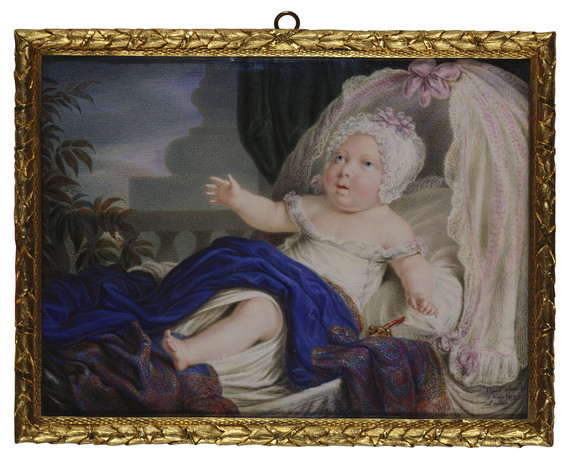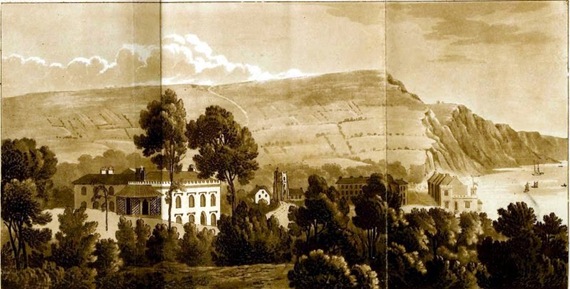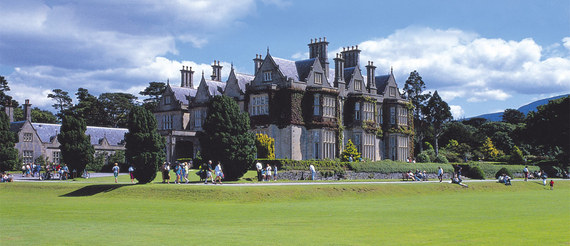With the premier of the PBS Masterpiece series, VICTORIA, airing on the 15th, it would be remiss of me if I did not point out that the occasion had been quietly celebrated at the manor of Woolbrook Cottage* in Devon.
Woolbrook was the home of Anne, the only child of the Cators in the group portrait below and her husband, Edward Baynes, Major General of the armed forces in British North America during the War of 1812. Barely a month later, however, the spirit of the Holiday season turned to grief when the Duke of Kent, the father of the infant princess, succumbed to a cold and died of pneumonia on January 23rd, 1820.
*Now the Royal Glen Hotel
Hidden in plain sight at the Aberdeen Art Gallery in Scotland is the singular target of the most breathtaking art heist in history. But unlike the much-touted 1990 Gardner Museum robbery in Boston, this one takes the cake not only for the sophistry of its conception but the brazen presumption of the perpetrators that their actions were for the well-being of the international black community.
It will undoubtedly come as something of a shock to most that the sitters in this picture of such frightfully aristocratic elegance were the grandchildren of Mary Augier, a black Jamaican slave woman.
What has stunned the academic world as well as the media, however, is the realization that the Morses had risen rather easily, indeed, even arrogantly so, from the state of slavery to the upper echelons of British society and influence in full view of the public. The fact that they did not have to "pass" and that papa's money proved to be all that was needed to "deconstruct" or "interrogate" the victimization paradigm that dominates, even sabotages the discourse on race is what has made this picture so intolerable in certain scholarly circles.
Considering how many more such Jamaican family histories have since come to light, certainly this one should prove a joyful revelation to viewers on both sides of "the pond," considering what it could contribute towards the racial peace, equality and harmony which for which we strive especially at this time of the year.
Sitting beside Anne Frances Augier Morse, the grandmother of the Hon. Henry Arthur Herbert of Muckross, Lord Lieutenant of Kerry, Ireland, is her sister, Sarah, the wife of John Cator seen standing. Their brother, Robert, is playing the cello. Similar to the relationship of their mother's first cousin, the Hon. Frances Duff, to the Royal Family today through the Earls of Fife, Sarah was the great, great grand aunt of Elizabeth Margaret Cator who married the Hon. Michael Claude Hamilton Bowes Lyon, the brother of the "Queen Mum" in 1928.
Because it also demonstrates the relationship of this, at the time, well-known family "of color" to Queen Victoria, it should also be noted that Anne Cator Baynes, was first cousin, on the Jamaican side, to Louisa Middleton, the mother the Hon. Henry Arthur Herbert, at whose architectural masterpiece, Muckross House, Queen Victoria stayed for two days during her state visit to Ireland in 1861.
Herbert, in turn, was the uncle of Maj. General, Sir Herbert Stewart (great grandson of the 7th Earl of Galloway on his father's side), who became the Aide de Camp to the Queen in 1882. His son, Capt. Geoffrey Stewart of the Coldstream Guards, also served the Queen as her Page of Honour. Between his sisters and his nieces, this branch of the Herberts intermarried with the Earls of Bantry, Dartrey, Minto and Ferrers as well as the Guinnesses.
Since so many of this echelon were integral members of Britain's wealthiest and most politically influential strata of society, how could this phenomenon not have had an enabling or, at least, mitigating effect on the circumstances of their still enslaved relatives living in the Caribbean?
Herbert's grandnephews are examples of how such individuals, in their attempts to shape or influence the development of the Nation's imperial power and ambitions along the lines of their own interracial identities, made careers for themselves in the colonial service. Sir Hubert Edward Henry Jerningham KCMG JP DL, for instance, was Member of Parliament for Berwick, Colonial Secretary for British Honduras, Lieutenant Governor of Mauritius and Governor of Trinidad and Tobago. Sir Wasey Sterry, CBE, served with the Foreign Service in both the Sudanese and Egyptian judiciary. It would be interesting to learn what part his African ancestry played in his marriage to the granddaughter of Princess Wishan of the Tewodros Imperial Dynasty of Ethiopia.
A great many more of this West Indian 'ilk', a majority of them Oxbridge educated, served as high-ranking officials in either the military or overseas government bureaucracies not only in Africa and the West and East Indies, but in Canada, Australia and New Zealand, to boot.
Indeed, it could be argued that the very complexity and apparently contradictory nature of these familial situations is what in many ways led not only to the cohesiveness, but the actual expansion of British influence in global affairs during the late 18th, 19th and 20th centuries.
BLACK LIVES MATTER, especially those on whose narratives the PC Police in both academia and the media have slapped an embargo.
As remarkable a breakthrough as this one has been, it is all too obvious that what could be obtained from several hundred others would barely scratch the surface of this potential subject, and an entire corpus of colonial and racial history will now have to be re-evaluated. What the process could contribute to a far more "empowering narrative" in comparison to the preconceptions and stereotypes so many academics and media pundits push like bad drugs, is as unimaginable to the general public as the saga of the Jamaican Augiers has been until now.



